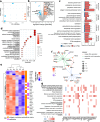Microtopography-induced changes in cell nucleus morphology enhance bone regeneration by modulating the cellular secretome
- PMID: 40645935
- PMCID: PMC12254341
- DOI: 10.1038/s41467-025-60760-y
Microtopography-induced changes in cell nucleus morphology enhance bone regeneration by modulating the cellular secretome
Abstract
Nuclear morphology plays a critical role in regulating gene expression and cell functions. While most research has focused on the direct effects of nuclear morphology on cell fate, its impact on the cell secretome and surrounding cells remains largely unexplored. In this study, we fabricate implants with a micropillar topography using methacrylated poly(octamethylene citrate)/hydroxyapatite (mPOC/HA) composites to investigate how micropillar-induced nuclear deformation influences cell secretome for osteogenesis and cranial bone regeneration. In vitro, cells with deformed nuclei show enhanced secretion of proteins that support extracellular matrix (ECM) organization, which promotes osteogenic differentiation in neighboring mesenchymal stromal cells (MSCs). In a female mouse model with critical-size cranial defects, nuclear-deformed MSCs on micropillar mPOC/HA implants elevate Col1a2 expression, contributing to bone matrix formation, and drive cell differentiation toward osteogenic progenitor cells. These findings indicate that micropillars modulate the secretome of hMSCs, thereby influencing the fate of surrounding cells through matricrine effects.
© 2025. The Author(s).
Conflict of interest statement
Competing interests: An Invention Disclosure has been filed for the mPOC micropillar scaffold through Northwestern University (X.W., V.A., V.B., and G.A.A.). G.A.A. is the inventor of US Food and Drug Administration-approved citrate-based biomaterials. The remaining authors declare no competing interests.
Figures






Update of
-
Micropillar-induced changes in cell nucleus morphology enhance bone regeneration by modulating the secretome.Res Sq [Preprint]. 2025 Jan 7:rs.3.rs-5530535. doi: 10.21203/rs.3.rs-5530535/v1. Res Sq. 2025. Update in: Nat Commun. 2025 Jul 11;16(1):6444. doi: 10.1038/s41467-025-60760-y. PMID: 39866882 Free PMC article. Updated. Preprint.
References
MeSH terms
Substances
Grants and funding
LinkOut - more resources
Full Text Sources
Miscellaneous

